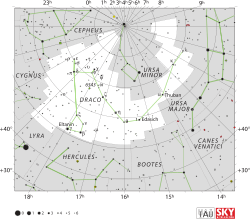Zeta Draconis

| |
| Observation data Epoch J2000 Equinox J2000 | |
|---|---|
| Constellation | Draco |
| Right ascension | 17h 08m 47.19596s[1] |
| Declination | +65° 42′ 52.8634″[1] |
| Apparent magnitude (V) | +3.17[2] |
| Characteristics | |
| Spectral type | B6 III[3] |
| U−B color index | –0.43[2] |
| B−V color index | –0.11[2] |
| Astrometry | |
| Radial velocity (Rv) | –17[4] km/s |
| Proper motion (μ) | RA: –20.43[1] mas/yr Dec.: +19.61[1] mas/yr |
| Parallax (π) | 9.93 ± 0.35[1] mas |
| Distance | 330 ± 10 ly (101 ± 4 pc) |
| Details | |
| Mass | 3.5[5] M☉ |
| Radius | 2.3[5] R☉ |
| Luminosity | 148[5] L☉ |
| Surface gravity (log g) | 4.24[3] cgs |
| Temperature | 13,397[3] K |
| Metallicity [Fe/H] | –0.95[3] dex |
| Rotational velocity (v sin i) | 55[6] km/s |
| Other designations | |
Zeta Draconis (ζ Dra, ζ Draconis) is the Bayer designation for a star in the northern circumpolar constellation of Draco. It shares the Arabic name Al dhi'bah ('the hyenas') with several other stars in the constellation,[8] and shares the name Al dhibain with Eta Draconis.[9] It is known as Nodus III (Third Knot, the knot being a loop in the tail of Draco).[10] With an apparent visual magnitude of +3.17,[2] it is the fifth-brightest member of this generally faint constellation. The distance to Zeta Draconis has been measured using the parallax technique, yielding an estimate of roughly 330 light-years (100 parsecs) away.[1]
In Chinese, 紫微左垣 (Zǐ Wēi Zuǒ Yuán), meaning Left Wall of Purple Forbidden Enclosure, refers to an asterism consisting of ζ Draconis, ι Draconis, η Draconis, θ Draconis, υ Draconis, 73 Draconis, γ Cephei and 23 Cassiopeiae.[11] Consequently, ζ Draconis itself is known as 紫微左垣四 (Zǐ Wēi Zuǒ Yuán sì, English: the Fourth Star of Left Wall of Purple Forbidden Enclosure.),[12] representing 上弼 (Shǎngbì), meaning The First Minister.[13] 上弼 (Shǎngbì) is westernized into Shang Pih by R.H. Allen with meaning "the Higher Minister".[14]
Zeta Draconis is a giant star with a stellar classification of B6 III.[3] Compared to the Sun, this star is about 2.5 times larger, 3.5 times more massive, and is radiating 148 times as much luminosity.[5] This energy is being emitted from the star's outer envelope at an effective temperature of nearly 13,400 K.[3] The azimuthal rotation velocity along the equator is at least 55 km/s.[6]
The north ecliptic pole is located at right ascension 18h and declination +66.5°.[15] This is located roughly midway between Delta Draconis and Zeta Draconis.[16]
References
- 1 2 3 4 5 6 van Leeuwen, F. (November 2007), "Validation of the new Hipparcos reduction", Astronomy and Astrophysics, 474 (2): 653–664, arXiv:0708.1752
 , Bibcode:2007A&A...474..653V, doi:10.1051/0004-6361:20078357.
, Bibcode:2007A&A...474..653V, doi:10.1051/0004-6361:20078357. - 1 2 3 4 Johnson, H. L.; et al. (1966), "UBVRIJKL photometry of the bright stars", Communications of the Lunar and Planetary Laboratory, 4 (99), Bibcode:1966CoLPL...4...99J.
- 1 2 3 4 5 6 Cenarro, A. J.; et al. (2007), "Medium-resolution Isaac Newton Telescope Library of Empirical Spectra – II. The Stellar Atmospheric Parameters", Monthly Notices of the Royal Astronomical Society, 374 (2): 664–690, arXiv:astro-ph/0611618
 , Bibcode:2007MNRAS.374..664C, doi:10.1111/j.1365-2966.2006.11196.x.
, Bibcode:2007MNRAS.374..664C, doi:10.1111/j.1365-2966.2006.11196.x. - ↑ Evans, D. S. (June 20–24, 1966), "The Revision of the General Catalogue of Radial Velocities", in Batten, Alan Henry; Heard, John Frederick, Determination of Radial Velocities and their Applications, Proceedings from IAU Symposium no. 30, University of Toronto: International Astronomical Union, Bibcode:1967IAUS...30...57E.
- 1 2 3 4 Malagnini, M. L.; Morossi, C. (November 1990), "Accurate absolute luminosities, effective temperatures, radii, masses and surface gravities for a selected sample of field stars", Astronomy and Astrophysics Supplement Series, 85 (3): 1015–1019, Bibcode:1990A&AS...85.1015M.
- 1 2 Royer, F.; et al. (October 2002), "Rotational velocities of A-type stars in the northern hemisphere. II. Measurement of v sin i", Astronomy and Astrophysics, 393: 897–911, arXiv:astro-ph/0205255
 , Bibcode:2002A&A...393..897R, doi:10.1051/0004-6361:20020943.
, Bibcode:2002A&A...393..897R, doi:10.1051/0004-6361:20020943. - ↑ "Zet Dra", SIMBAD, Centre de Données astronomiques de Strasbourg, retrieved 2009-10-10.
- ↑ Allen, Richard Hinckley (1899), Star-names and their meanings, New York: G. E. Stechert, p. 210.
- ↑ Rumrill, H. B. (June 1936), "Star Name Pronunciation", Publications of the Astronomical Society of the Pacific, 48 (283): 139–154, Bibcode:1936PASP...48..139R, doi:10.1086/124681.
- ↑ Kaler, Jim, "Al Dhibain ("The Posterior")", Stars, University of Illinois, retrieved 2009-10-12.
- ↑ (Chinese) 中國星座神話, written by 陳久金. Published by 台灣書房出版有限公司, 2005, ISBN 978-986-7332-25-7.
- ↑ (Chinese) AEEA (Activities of Exhibition and Education in Astronomy) 天文教育資訊網 2006 年 6 月 10 日
- ↑ (Chinese) English-Chinese Glossary of Chinese Star Regions, Asterisms and Star Name Archived August 10, 2010, at the Wayback Machine., Hong Kong Space Museum. Accessed on line November 23, 2010.
- ↑ Star Name - R.H. Allen p. 210
- ↑ Chartrand, Mark R.; Wimmer, Helmut K. (2001), Night Sky: A Guide To Field Identification, Macmillan, p. 12, ISBN 1-58238-126-7.
- ↑ Young, Charles Augustus (1919), Anne Sewell Young, ed., The Elements of Astronomy: a Textbook, Ginn and company, p. 69, retrieved 2009-10-12.